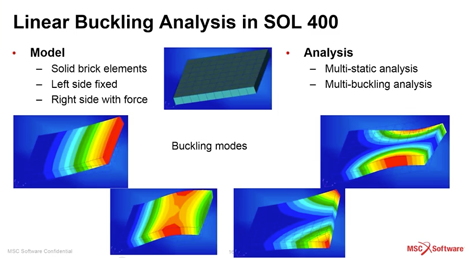
Nastran 2014 has improved its ability to simulate flexibility in defining combinations of load cases
MSC Nastran 2014 has been announced, giving the simulation software new solver embedded fatigue functionality and analysis abilities.
Several enhancements have been added with the goal of improving the efficiency and ease of use of MSC Nastran’s solver embedded fatigue capabilities.
These include support for seam and spot welds fatigue analysis (feat for identifying critical welds in automobiles and other structures subjected to repeated loads), multi-axial assessment and support for industry standard remote parameter control files.
Its external superelement (SE) capability has been enhanced, giving users the ability to rotate, move or mirror a primary external SE. This capability is designed to reduce the modeling effort needed for full vehicle analysis with duplicate assemblies like aircraft engines attached to wings, or landing gears attached to the fuselage.
The ability to activate and deactivate rigid elements in subcases has been added, along with improved flexibility in defining combinations of load cases often used for safety related industries and airline certification.
Other additions include robust contact capability for assembly modeling, which is often used to join discontinuous meshes or general contact including friction and heat transfer.
In Nastran 2014 it is no longer necessary to identify the master and slave body and reduce the dependency on the mesh size, leading to simplified set-up time.
Solutions for complex problems such as eigenvalue extraction on pre-stressed bodies encountered in the wind turbine arena have also been improved.
Explicit nonlinear analysis capabilities of MSC Nastran are often used to solve complex fluid-structure interaction (FSI) problems, which require large computational resources. Defining the coupling surface between the fluid and the surface looks to have been improved for this, with MSC stating that performance on multi-core configurations has improved by a factor of two to allow more design studies.
As well as using more multi-core grunt for nonlinear solutions, model frequency response analysis is improved with claimed three-times faster performance in frequency computations for non-symmetric systems.
Targeted at the automotive industry, this is important for where the inclusion of tire rolling models results in non-symmetric models.
Other enhancements in this release include improvements to axisymmetric harmonic concentrated mass element, and new outputs for composite shell elements.
Elsewhere, MSC’s new release of pre/post-FEA processing software Patran provides support for the new capabilities in MSC Nastran and MSC Fatigue, with CAD import and export capability has been improved to support recent CAD systems.
The GUI drives the new MSC Nastran Embedded Fatigue capabilities. As model size increases to ensure greater fidelity of the model, Patran 2014 has been enhanced to provide faster visualisation.
//www.youtube.com/embed/tHJ_SZedbMM






